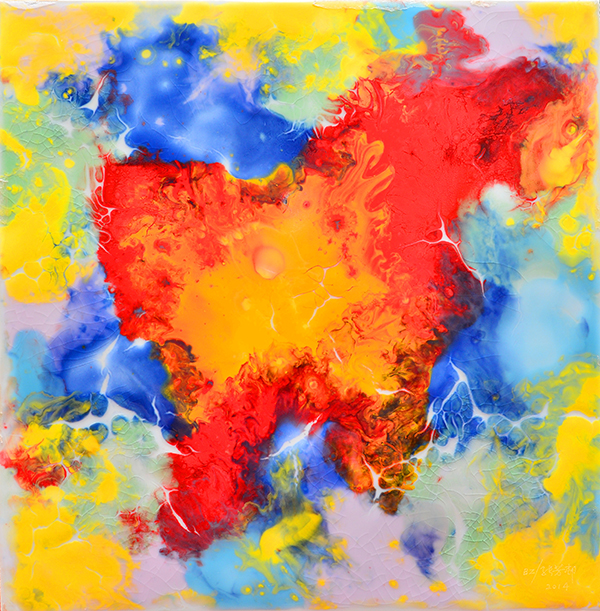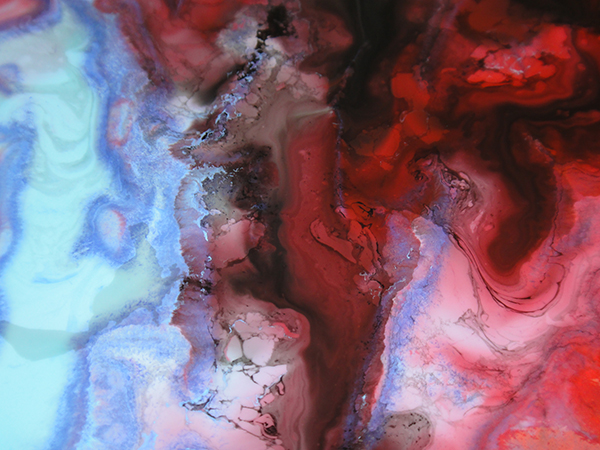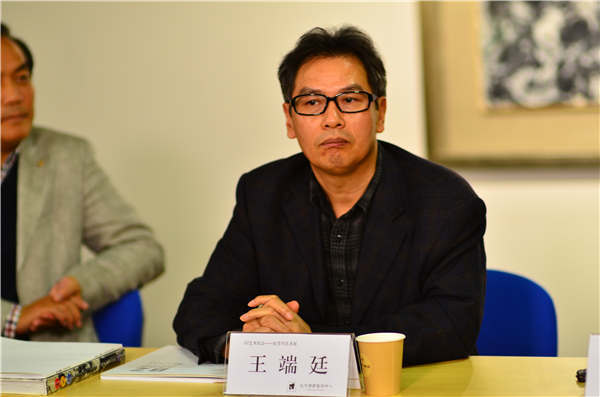Decisive Point of Art and Science——Discourse of Zhang Fang-cun’s BZ Art basic upon the artistical history

色彩的解密与革命——张芳邨“BZ艺术”解读
201828. augustil
Teaduse ja kunsti kriitilisest punktist – Zhang Fangcuni BZ-kunsti olemus, mis põhineb kunstiajaloo vaatel
201828. augustil
Decisive Point of Art and Science
Discourse of Zhang Fang-cun’s BZ Art basic upon the artistical history
Written by Rong Jian(kuulus kunstikriitik)
Art, religion and science are the three major structure in human spirit world, i.e. a principal symbol for human to depart from animal world and walk toward civilization. Thirty thousand years ago, human dwelled in caves, having not enough food and clothes, nevertheless, wings of the artistic imagination had been spreading; they used the dirt, mineral material, and mixed animal grease to paint down the earliest art work on the cave wall. With the onset of art, follow the birth of religion. For the realistic predicament, human tried to realize a spiritual Nirvana to transcend their limited life cycle, and then entered an infinite imagination. Science far lagged behind art and religion to descend on earth; from ancient Greek Age to Galileo times, science made every effort to get rid of artistic and religious shackles all the time, in other aspect, its progression was also changing the art and religion. Artistic revolution of Impressionism in essence was the optics revolution while the religious reformation was completed under the pressure of science. seega, science is the collective catalyzer for transformation of art and religion.
As to the art influenced by science, Kim Lerving , American famous art critic, wrote on his book —the "Post-modern Transformation" as "Modern art is scientific and established on beliefs to convince future technology, global progression, and subjective truth. It is experimental, and to create a new morphology is its important mission. Ever since the impressionism boldly gets involved in optics, the art has started sharing the scientific method and logic. There are many sects trying to use rational technique to rein these irrational matters, including the cubism established by Einstein’s relativity, constitutivism with industrial skill effect, futurism, de Stijl, Bauhaus and Dadaists’ graphic mode, or even the surrealism image set by theory of Freud’s Die Traumdeutung (the interpretation of dreams), and modernism behavior mode affected by psychoanalysis process. The reason is, people in the phase of modernism believe scientific objectivity and invention, thus, its art has the structural orderliness, dreaming logic, figure posture, and material rationality; they yearn for purity, clearness, and order". The circumstance that science then was integrated into art (described by Lerving) was indeed constituting a mainstream in the modernism art movement, or even turning into an orgy held by machine and technology in artistic domain during 1960s. Art masters, e.g. Robert Rauschenbery, Bob Whitman, jne., were scrambling for the aid of various industry techniques to express their obsession onto science. These phenomenon demonstrates, within a very long timeframe, modernism relies on scientific gigantic momentum to create new art formations and sects.
How should we regard the "Scientificity " of modernism art? Or we may say, how to treat the relation between art and science? The artistic history and the scientific history bot are obviously not reaching a common consensus. In the view of some cultural criticizing scholars, e.g. the critique onto culture and industry dominated by Frankfurt Sect, it shall emphasize the analysis on the negative influence caused by science to art; actually, they assumed, artistic scientificity is closely tied to the enlightenment fall and the humanity decay. seega, it means, art is associate with the industrial conception, such as the repetition, standardization, assembly line, and the batch production. In other words, the scientific art is equivalent to the cultural industry of capitalism, citing their words,"all cultural industries comprise the repeated factor.
The exclusively unique innovation of the cultural industry is no more than a mass production unceasing in improvement, rather than the matter outside the mechanism; it is sufficiently specifying that all consumers’ interest is oriented by technique instead of contents, and the said contents are confined to an endless repetition, continuously rotten in people’s doubtful mind. In the sight of Frankfurt Sect, cultural industry is a common reproducing culture; all elements are under the identical mechanism, tagging the same label. As culture turns into the implication of the schematization, index, and classification, the argument between artistic expert and auditor has proofed that the esthetically internal tension is existed no more. The worldwide internal criticalness and negativity is completely resolved through the filtration of cultural industry, thus, the technique rationality has become the role to dominate the rationality, and the society is alienation in mandatory nature in itself.

To the best of my knowledge, realistic progress of the modernism esthetics actually is not what Frankfurt Sect thought — completely on the scientific track to be reproduced, and gradually walked towards the fall. Since impressionism painting raises the curtain of artistic modernism, the modernism even since has become a part of the rationalism propagandized by the Enlightenment, adapting to the entirely social "De-demonization". Modernism exorcises the political and religious ideology from artistic domain through diverse vision images of the classic art, hence, art can authentically regress to itself. The color revolution represented by impressionism and Fauvism, as well as the modeling revolution by Picasso, is an unprecedent innovation in art history. seega, the artistic modernization, in terms of its imaginative and creative essence, is basically opposite to the scientific technic and repetition. As science and industry bestows a certain for upon modern art, it does not restrain the space of artistic imagination, nor dispel its "staged authentication". During the period of modernism, it was really as what Habermas said, art obtained the important position equivalent to science, becoming a domain of the autonomous value in the 20th century. Self-discipline of the modern art is not fatally affected by extensive application of the photographic technics. Within decades after the "Replica Art" proposed by Ben Ya-min, modern art was rapidly developed in America and Europe according to its logic and engendered several important art sects such as German neo-express****** and American abstract express******.
During the same period, however, modernism art encountered an authentic crisis; as Kim Lerving said,"Modern art promises a rosy and resplendent future, an endless style progress, but at 1968 or thereabout, people couldn’t persist in the optimism to modern art, the arbitrary conviction to technology and science, and the reliance to the process of purity, logic, and formation. Infinite progress and development is being substituted for defect, fault, inflation, and devaluation…living in a no-simplification world, we perceive, the purification is impossible, and the modernism has been dead…"
On a stretch of ruin of the modernism, the post-modern art start emerging, and within the short decades, it has swept across the Europe and the US as a counter-revolution or transcendence onto modernism art. Post-modern art performs an esthetic standpoint entirely different from the modern art; the former attacks the conception of"self-discipline of the art work" and "Esthetic self-discipline" which used to be the philosophic footstone of modernism. In the post-modern context, art can be everything, yet cannot belong to itself. Duchamp, father of the post-modern art, announced in the early of the 20th century — the most common object can be a kind of art. Being asked — "what is art ?& Quot;, he gave a classic response as "What is not art ?"

In the post-modern, repetition and identicality are no more the fatal enemy in art. No style becomes a style while the "collage", "appropriation" and "simulation" become the chief technique to demonstrate art, as well as the industrial standard production and assembling-line operation are introduced into the art production with a great fanfare. Artist’s duty is merely selling his concept; he can employ workers, like the capitalism boss, to draw paintings without any moral reprimand. Public simulation, or even plagiarism, becomes a kind of fashion, thus, it results in Jameson, the US culture criticism master, described such a situation as "To date, there is no any society like this one being totally standardized, and the short stream of human, society, and history has never flown in such an even speed". Obviously, in the context of post-modern history, artistic homogeneity and reproduction is really ascending from technical layer to a kind of concept or philosophy . The key words in relation to"Reproduction" include the "collage", "appropriation", "simulation", and "graph"; these words subvert the academic elite tradition which has long been formed in modernism and rapidly submerging art into the consuming wave of popularism. The artistic reproduction that Ben Ya-ming catches sight from films and photographs has become an artistic mainstream in our times while the said reproduction has the aid of computer and media to create a huge effect. It is not difficult for us to understand, why the contemporary art in Chinese still remains in its social matrix, or in the swaddling period of modernism, and is struggling to free in haste, so as to achieve its post-modern transformation. Under circumstances of the apposition of the pre-modern, modern, and post-modern, the utterance of "Reproduction" has impressively become mainstream utterance of the contemporary art in China; it dominates and affect the production of Chinese contemporary art to repeatedly produce the classic vision emblem of those post-modern art.
If the modern and post-modern art history is demonstrated basic upon the relation between art and science, has it been exhausting all relation between the same? The independence expressed by modern art to science, as well as the tangle of post-modern art and science, does it mean that art is still necessary to take a further consideration within the scientific dimension? This is the issue and consciousness emerging in my mind when reading and interpreting Zhang Fang-cun’s BZ Art. In the art history since impressionism, science has never absent from the very beginning, using diverse methods to intervene in the artistic creation and transition. Nevertheless, we must point it out, either basic upon modern stance or post-modern, science is always intervening in artistic domain"indirectly", emerging from the artistic background, or appearing as an artistic instrument (post-modern). In the phase of two different arts, both artistic and scientific mechanisms are respectively existed and independent, therefore, Zhang BZ Art eristada tähtsust mineviku kunsti ajalugu seisneb teaduse mis on debüüt & quot; otse & quot;, siis, liitub kunstiloomingu. Ta järeleandmatult murrab läbi kriitiline punkt kunsti ja teaduse, ja orgaaniliselt ühendab teaduse reaktsiooni kunstilooming, täiendavalt luua unikaalne kunsti — BZ Art.
First of all, Zhang’s BZ Art is not an unconventional statement, but a serious science axiom. "BZ Reaction" was mutually discovered by two Russian scientists — Belousov ja Žabotinski, sisse 1959 (and named after their initials respectively as "B" and "Z"). BZ Reaction actually is a kind of chemical oscillation. With an appropriate catalyzer, such as the function of manganese and cerium, using malonic acid to oxidize MSDS, siis, mixing it with the solvent in Petri dish, we may see the colored ripple continuously radiate in the middle of dish; the solvent is first changing into blue, siis, red and blue in sequence. If we continue adding substance, the reaction will constantly change. This reaction is completely a kind of chemical clock, which is what so-called the self-catalysis — it means, the reactive product can catalyze the reaction and accelerate its synthetization. BZ Reaction demonstrates that reciprocation can be used as a method to provide oscillation, and the simple ingredient in non-living system can spontaneously engender a complex mode and structure. Zhang applies BZ’s chemical reaction directly onto the canvas for various pigments to create self-reaction and appear with unprecedent pattern and tableau which is unique, unrepeatable, and impossible to generate what so-called the fake painting. The said pigment is self-organized, and the tableau is spontaneously formed by self-movement of the pigment. Art relying on natural reaction (BZ reaction) of the pigment has shifted the artistic concept and express*** subsumed in traditional significance ever since, and created infinite possibilities of unprecedent morphology.

The next, Zhang’s BZ Art is a direct revelation of scientific art; relation between art and science is external no longer, but an internal connection. According to traditional science view, science is consisted of logic and ration, thus, the object observed by science is very difficult to connect with art, for scientific image is nowhere to be expressed. In practice, as all ugly things in reality are regressed to the minimum molecule or atom under a microscope, people can catch sight of the most beautiful scenes; science can not only explore the "truth" but also display the "beauty". The profound mystery in Nature is consisted of the innumerably self-organized movements. BZ Reaction is to display the "Nature Beauty", or we may also name it as the "Science Beauty". Decisive point of art and science is broken in BZ Art; we can call BZ art as a scientific art, or an artistic science.
The third: BZ art is not only a reformation and reconstruction of the painting pigment, but also a new painting material (in application), or a new art concept and method (breakthrough). Through BZ reaction the pigment will conduct a self-organized movement to form a tableau effect on the canvas, rice paper, klaas, pottery, and porcelain plate, which is the product of scientific reaction, or a natural outcome made by Nature. The material reformation is necessarily bringing the reformation of artistic concept and method. express***s of the "Nature" have changed the traditional meanings in paintings to substitute the idiosyncrasy of intentional concoction, production, and depiction. Viewing from this significance, we may read, maybe BZ Art can surpass the color revolution created by Impressionism; it has a keen sight into the principle and mechanism of color, variation, and synthetization to have art regress to the realm of "Integration of heaven and human" and "Natural generation". Artist’s subconscious emotion development, soul intervention, and conceptional dominance is using a form of "Materialization", or a self-organized movement launched by physics and chemistry, to reach a harmony and appearance. In the process of BZ Reaction, the material pigment is self-catalyzed in one hand, and the subject is integrated with the object in the other, siis, the simple ingredient in non-living system is evolving into a complicate mode and structure to form a beautiful and magnificent picture that both the Nature and the human are unimaginable.
The fourth: BZ Art is a self-organized art, an art embodied with nature, or an occasional art; therefore, people may ask — where is the artist’s subjective status? Is artist’s standpoint same as scientist’s? will artists use various tubes instead of brush pen? Doesn’t that such a painting scene subverts the traditional painting operation? Jackson Pollock’s dripping painting has subverted the traditional painting on racks, and the accidental painting effect he pursued has been accredited by art history as a decisive factor to reach his artistic achievement. In comparison with Pollock, Zhang’s BZ has an even greater contingency in the process of operation. Success rate of his works is approximately no more than 20% while the porcelain painting could be even lower (less than 10%). With such a low survival rate, on one hand it can be regarded as self-produced work, and on the other hand it can be regarded as artist’s autonomous selection. In the duration of the process abovementioned, artist’s subjectivity is embodied on the artistic judgment being comprised of his concept, emotion, and experience. His subjective intervening mode is diverse, such as regulating formula, changing reagent, increasing or decreasing a certain of pigment, and guiding pigment’s flowing direction and intensity. When the tableau reaches the optimum condition, the artist will make the final decision to complete this work. Hence, BZ Art to an artist is not a passive art process, for it not varies the relation between artist and work. Only subject and object reach the perfect integration, can the work be created "by the way".

I don’t think Zhang’s BZ Art has solved all issues in respect of the relation between art and science once for all, but his art exploration at least gets involved in following issues worth criticism to pay utmost attention;
BZ Reaction is can have the painting media resurrect from "Dead material" to "Alive material", and the self-organized movement caused by chemical reaction of the pigment could thoroughly change all previous painting mode and method.
The painting made by BZ Reaction is direct display of the scientific art rather than indirect intervention. Scientific reaction and artistic creation both have approximately same purport and realm. Science and art are opposite but appeal in unification.
BZ Art is an art embodied by Nature, or an occasional art. Artist’s subjectivity consists in the transient"freeze-frame" to catch the occasional art effect; subjective and object must be highly integrated.
BZ Art is unifying scientific reaction and artistic creation, art and craft, art and technics, and art and science, as well as art and the Nature, of course. The boundless universe actually is an integer.
"The End of Art" proposed by Arthur Danto is based on art, but its possibility has been thoroughly destroyed; I assumed, Zhang’s BZ Art could demonstrate another new possibility.
Rong Jian
2017.10.5

Rong Jian: Doctor of Philosophy (Ph.D), kuulus kunstikriitik, and curator. The Beijing Jindu Art Center was established in 2005. Since April, 2006, it took place the "Exhibition of Chinese abstract art series" under the theory subject of "The third space"; to date, more than twenties exhibits have been held. The said exhibition won its good reputation and accredited by the profession as the most important art institution in promoting abstract are in China. Rong Jian published more than million-word theory articles on the "Chinese Society Science", "Philosophy Research", "Politics Research", and "Guang Ming Journal", and printed various writings inclusive of the "Democracy"(Shanghai People Publisher in 1989), "Transcendence and Convergence"(Chinese People University Publisher in 1988), "The Creative Exploration of Marx’s Later Years"(Henan People Publisher in 1993), and the"Theory and Method of Social Criticism"(Chinese Society Science Publisher in 1998); among them, "Democracy" was engendered an important influence and has been collected by the Library of the US congress as the classic reference.
 |
|



